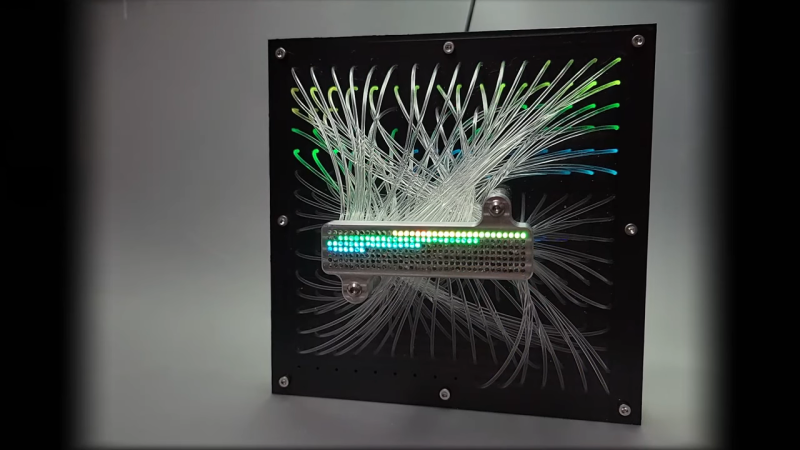Everyone loves LED matrices, and even if you can’t find what you like commercially, it’s pretty easy to make just what you want. Need it big? No problem; just order a big PCB and some WS2812s. Need something tiny? There are ridiculously small LEDs that will test your SMD skills, as well as your vision.
But what if you want a small matrix that’s actually a big matrix in disguise? For that, you’ll want to follow [elliotmade]’s lead and incorporate fiber optics into your LED matrix. The build starts with a 16×16 matrix of WS2812B addressable LEDs, with fairly tight spacing but still 160 mm on a side. The flexible matrix was sandwiched between a metal backing plate and a plastic bezel with holes directly over each LED. Each hole accepts one end of a generous length of flexible 1.5-mm acrylic light pipe material; the other end plugs into a block of aluminum with a 35 by 7 matrix of similar holes. The small block is supported above the baseplate by standoffs, but it looks like the graceful bundle of fibers is holding up the smaller display.
A Raspberry Pi Pico running a CircutPython program does the job of controlling the LEDs, and as you can see in the video below, the effect is quite lovely. Just enough light leaks out from the fibers to make a fascinating show in the background while the small display does its thing. We’ve seen a few practical uses for such a thing, but we’re OK with this just being pretty. It does give one ideas about adding fiber optics to circuit sculptures, though.















That’s beautiful. I love the way the ouptut LED’s are offset from the fibres so you get really neat patterns in the background.
FiberTech Optica makes amazing scientific-grade fiber arrays. Hard to express how cool their stuff is. Note that most of the photos are arrays of 100 micron fibers, many with 2D grids where fibers positioned within a few microns of the ideal positions.
https://fibertech-optica.com/linear-fiber-arrays/
I wasn’t sold on the idea from the static picture, but it looks great in motion! I particularly like the way the background changes when it’s showing the digital clock.
So how exactly would we buy one? That looks amazing! I like the clock animation.
Looks like a hard drive defragging
Imagine if you were looking at a display and every pixel was the end of a fine fiber optic fiber. How cool would that be!
Awesome !
Reminds me of an incredible advertizing display for the Nikon Pronea camera : there was a 12 v 50 w bulb passing thru coloured filter turning slowly, and the light could animate the display that was an array of many more optical fibers, difficult to describe, but it was exactly the same visual effect (exept you couldn’t see the guts of the thing), but all analog, and with only one “program” that was hhe multicoloured filter, fantastic light engeneering ! it was made in Nederlands.
Incidentally, the opposite way, i. e., going from a closely packed array of fibers to a more spaced configuration of their outputs is a very interesting technology in astronomical observations, since it allows image spectroscopy. https://www.eso.org/public/teles-instr/technology/ifu/
Some of the most advanced recent telescopes are mind-blowing. Here’s a great paper that shows these fiber arrays and positioning mechanisms for the Subaru telescope in detail. Fibertech Optica fabricated the fibers for it. The linear bundles go into the spectrographs, while the other ends are moved around using hundreds of robotic micromanipulators. Hackaday should make a writeup on Subaru & the systems involved.
https://arxiv.org/ftp/arxiv/papers/1807/1807.08036.pdf
https://www.subarutelescope.org/en/about/instrument/fmos/index.html
Years ago I dreamt up the idea of doing this to an entire room. It would be awesome to do this to a 14’x14’x10′ room and get it at 75DPI. It would probably be a lot less crazy to do that now than it was when I was doing the math in my head for it back in the early 2000’s
There used to be a publication called Readymade Magazine. Featured an art installation that did somewhat the opposite of this. Miles worth of fiber optic filament ran from the front of a CRT television and on the other end they were spaced apart 12″ (or so). The effect was a very low resolution but absolutely giant jumbotron like image.
I’ve searched on a number of occasions to find again who did it, some images, etc. but I’ve never been able to relocate those details.